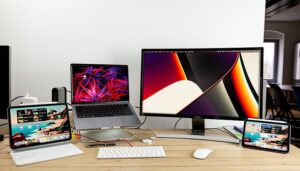Last year, Apple presented a feature that we were all waiting for: Universal Control. This is not an Apple exclusive software option, but that doesn’t mean that it’s less important. Our team was able to test the Universal Control feature and here is how it works with the iPad and the MacBook.
What is Universal Control?
First things first! Universal Control is a feature that lets you control multiple iPads and Macs using a mouse, a keyboard, and/or a trackpad. You can move the cursor and keyboard seamlessly between the devices. This is all enabled via iCloud, which is responsible for controlling the cursor activity.
As mentioned, the feature is only available on iPads and MacBooks, so it’s still not possible to use this option on the iPhones. It is enabled by default, so there’s no setup required! However, in order for it to work, there are some requirements:
Software compatibility: iPadOS 15.4 and macOS Monterey 12.3 releases (in developer beta for now) or later.
An iCloud account: The devices must be signed in to the same iCloud account.
If your devices check all the boxes above, you can start using Universal Control to navigate between screens and improve your experience with both iPad and MacBook.
2021 Apple iPad Pro 11-inch for $1,429
2021 Apple iPad Mini for $644
Apple MacBook Pro 14 inches for $1,950
How does Universal Control work?
We were able to test the Universal Control feature on the iPad Pro 2019, iPad mini 2021, MacBook Pro 14’’ and an extra Samsung display. As for peripherals, we used Apple’s Magic Keyboard and Magic Mouse. In our hands-on, you can see how easy and practical the Universal Control can be:
As you can see, it is super easy to jump the cursor between devices, and it works as smoothly. One thing that caught our attention is that the cursor design has been kept in the pattern already used in both iPadOS and macOS, so it’s nice to see that Apple didn’t create a new icon for it.
Apple Magic Keyboard for $95
Apple Magic Mouse for $75
The highlights of this feature are to drag and drop photos and files between devices without the need to share them first, to interact with different apps by swiping screens is also magical, as well as launch apps using spotlight search and stream videos and musics with a few clicks on the mouse. In other words, it is a helpful tool to have while using Apple’s ecosystem.
I would love to have this feature available on my iPhone too, so I could quickly interact between my MacBook and phone, but we are not there yet.
How to enable or disable Universal Control?
At the end of the day, maybe you would like to disable the feature just in case you don’t get familiar with it or just feel annoyed by it. And the good news is that enabling and disabling Universal Control only requires a few steps:
On the iPad: Access the Settings app > General > AirPlay & Handoff > Cursor and Keyboard toggle.
On the Mac: Universal Control settings can be found in the System Preferences > Displays.
And since we are already in the setup area, what about making sure that you are taking the best from Universal Control on your devices? I will share below some changes you can apply to optimize your experience with this feature directly in the System Preferences of your MacBook:
Allow your cursor and keyboard to move between any nearby Mac or iPad: This will enable your cursor and keyboard to be used on any nearby Mac or iPad signed in to your iCloud account.
Push through the edge of a display to connect to a nearby Mac or iPad: By setting this option up, you will allow the cursor to connect to a nearby Mac or iPad by pushing against the edge of the display.
Automatically reconnect to any nearby Mac or iPad: Activating this option allows your Mac to automatically reconnect to any nearby Mac or iPad you’ve previously connected to.
This is all that we have today about the Universal Control feature. Personally, I hope I will get more things done by using this feature in a daily basis, especially because now I can use an iPad as a functional second display. Plus, my desk will be much cleaner since my second screen is basically the size of my MacBook monitor. If you also share Marie Condo’s teachings, then you know how important it is to have things that sparkle joy!
What do you think of Apple’s Universal Control feature? Are you already using it? Or do you use another solution from a different brand? Let us know your opinion in the comments below.
Source: https://www.nextpit.com/apple-universal-control-how-to-use-ipad-mac
- https://www.nextpit.com/
- Apple
- United States









